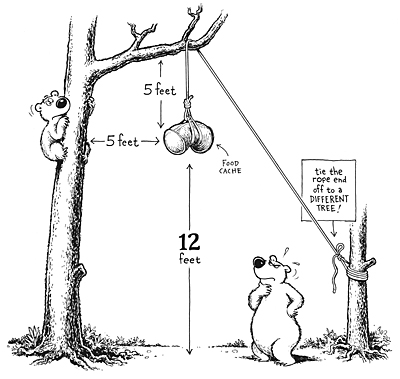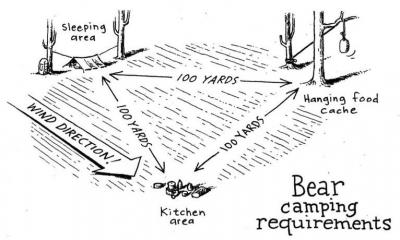Recently I wrote a post called “You Killed A Bear” that ended up getting way more online attention than I had anticipated. My message in that post was that less experienced hikers should read up about bear safety before they head out for a hike or go backcountry camping. Lots of people asked questions about staying safe in bear country so I’ve rounded up the best bear safety tips from around the web for hikers, drive-in campers, and backcountry campers and some tips on what to do if you see a bear.

Hey there: This post may contain affiliate links, which means I earn a small commission at no extra cost to you if you make a purchase. Thanks for supporting my website! – Taryn
Bear Safety Tips for Hikers
- Check conditions before you go on parks websites or on trailhead signage. If there is a bear in the area (especially if it has been aggressive or has cubs) be prepared or consider hiking somewhere else.
- Watch for bear signs along the trail including scat, tracks and scratches on trees.
- Make noise by talking or singing to announce your presence as humans. The sound of bear bells does not carry as well as the human voice. Make more noise in areas where you are more likely to see or surprise a bear such as in dense brush, near berry patches or in areas with fresh bear signs.
- Avoid encountering a bear by staying on the trail, hiking during the day and leaving the area immediately if you find a dead animal.
- Hike in a small group rather than alone, as bear attacks on groups are virtually unknown.
- Keep pets on a leash. Roaming dogs can agitate bears which then might chase the dog back towards hikers. Not a fun situation for anyone!
- Take care to pack out any garbage or food as it can attract bears. This includes things like apple cores, banana peels and egg shells which give off odor could lure in bears. Remember, a fed bear is a dead bear, even if you accidentally feed it garbage.
- Carry bear spray in place you can reach it quickly (such as attached to the shoulder strap or hip belt of your pack or in an easy to grab outside pocket). Bear spray is relatively lightweight and inexpensive and has been shown to be a better way to stop a bear attack than a gun. You can also carry bear bangers or a small air horn as an additional tool to frighten off bears but they don’t replace bear spray. Find more info on how and when to use bear spray on bearsmart.com.
I recommend: I always carry bear spray if I’m hiking in bear country. I carry it in the side pocket of my pack where I can grab it easily. Buy: MEC | REI.
Bear Safety Tips for Drive-in Campers
- Check conditions and facility information on the campground website before you go to find out if any bear precautions are recommended or required (such as the Bare Campsite Program).
- Keep a clean campsite: Cook and eat in the same area (preferably away from your tent). Make sure you clean up thoroughly when you are done including any food scraps or spills.
- Store your food (including your cooler), cooking equipment, and toiletries (including sunscreen and bug spray) in your car at night or anytime you are not in your campsite. Never store food or beverages other than water in your tent.
- Place all garbage in a bear-proof garbage can or in your car. Don’t burn garbage in your firepit as it may not burn fully and could still attract bears. Don’t leave garbage in the firepit when go home, expecting the next camper to burn it.
Bear Safety Tips for Backcountry Campers
- Check conditions and facility information on the park website and trailhead signage before you go to find out if any bear precautions are recommended or required. In particular, find out if any food storage or cooking facilities are provided.
- Pick a campsite that is not near game trails, berry patches, or animal carcasses. Avoid blocking access to water sources.
- If you stay at a backcountry campground that has a kitchen shelter, picnic tables or fire rings, use these areas for cooking and eating.
- If there is no designated cooking area, cook and eat in an area 100 meters (100 yards) away from your campsite and the campsites of others. Ideally, your campsite should be located 100m away from your cooking area, which should be located 100m away from your food storage area. Think of these three areas as forming a triangle with each side of the triangle being 100m long.
- Keep a clean cooking area. Make sure you clean up thoroughly when you are done including any food scraps or spills. Never leave garbage in campsites, firepits, cooking areas or on trails as it can attract bears. This includes biodegradable food waste like apple cores, sandwich crusts, banana peels and eggshells.
- Clean your dishes and disperse graywater widely or in a cat-hole away from your campsite and cooking area. Strain out food particles and pack them out with your garbage.
- Never store food, garbage, cooking equipment, toiletries, clothing with spilled food on it, or other scented items (including menstrual supplies) in your tent or backpack. At night or anytime you are away from camp, store these items in a bear-safe manner (see below).
- There are several ways to store food securely in a bear-safe way in the backcountry:
- Choose to stay in a designated backcountry campground that has a provided bear locker (a metal locker) or a bear pole (a pole with hooks on it for hanging your food bag).
- If a bear locker or bear pole is not available, you will need to construct a bear hang: suspending your food bag from a tree branch at least 1.5 meters (5 feet) from the hanging branch and the trunk of the tree and 4 meters (12 feet) off the ground. Plan ahead by bringing a rope, carabiner and sturdy stuff sack or dry bag to make your hang. This technique can take a lot of practice and is difficult in some areas so give yourself lots of time instead of waiting until it is dark to put up your bear hang. You can find lots of instructions for building a bear hang online.

- In some areas (some American National Parks) the use of bear canisters is required or recommended. These sturdy hard plastic containers require tools and/or thumbs to open and thankfully bears have neither. You fill them with your food, garbage, toiletries, etc. then store then well away from your campsite. Bear canisters are heavier, hard to pack, more expensive and bulkier than using a stuff sack and rope. But they are MUCH easier to use. If you camp often in places where bear lockers or poles are not available or above treeline (where bear hangs are impossible), consider investing in a bear canister.
I recommend: I own a Garcia bear canister, a Bear Vault bear canister and an URsack. I prefer the Bear Vault as it is the easiest to pack.
What To Do If You See A Bear
Bears are good runners, swimmers, and tree-climbers. They are definitely faster than you! They also can hear, smell and see better than you can. Thankfully they are usually afraid of you and often just want to be on their way. Here are some basic tips on what to do if you see a bear. Far more detailed tips can be found on the websites like bearsmart.com and others listed in the Further Reading section of this post.
- Be prepared to leave the area and end your hike. If the bear acts aggressively, doesn’t leave the area or you can’t safely make a wide detour around it, save the hike for another day.
- Get your bear spray ready by taking the safety off.
- Don’t run or try to climb a tree. Instead back away slowly while speaking to the bear softly and avoiding eye contact.
- Don’t try to get closer to take photos. Give the bear space.
- Don’t play dead. Black bears eat carrion (dead animals) and that just makes you more attractive. (But note that playing dead can work in some situations during a grizzly bear attack such as a defensive attack where you surprise the bear.)
- Don’t offer the bear food in an attempt to distract it.
- If a black bear comes into your campsite, give the bear a clear escape route, then have your group stand up together and make noise by yelling or banging on things to try to scare the bear away. Unfortunately, this doesn’t work with grizzly bears so it’s probably you who will have to move.
- If the bear comes within close range, use your bear spray and aim for the bear’s eyes.
Further Reading on Bear Safety
BC Parks Bear Safety Guidelines
Parks Canada Camping in Bear Country Guidelines
More Posts About Backcountry Safety and Ethics
- How to Leave No Trace (And Why it’s Important!)
- How to Leave No Trace With Dogs
- How to Camp and Hike on Your Period
- Backcountry Hygiene the Leave No Trace Way
- Tips for Hiking Alone
- The 10 Essentials: Things You Should Bring on Every Hike
- 16 Things to do Before a Hike
- My Favourite Hiking Gear of 2025 - December 9, 2025
- Best Insulated Skirts For Hiking and Snowshoeing in 2026 - December 5, 2025
- Snow-Free Hikes in Vancouver: 50+ Year-round Trails - December 4, 2025



Zulfikar
Monday 5th of April 2021
Thanks Taryn. Lately, I have completed a hiking trip “Big Cedar and Kennedy Falls” I read your post and tips for hiking! Thanks All-mighty! Nothing happened to me!! Missed some of the 10 essentials?!! It is my second and solo hiking trip?!
Looking forward to see more Post from you on BC Hiking trips.
Lori
Tuesday 28th of April 2020
Great tips Taryn! We camp in our RV and have had bears come through our campground several times while we were sleeping. I hope to never encounter a bear face to face! Thanks for the great info!
Laurel E
Friday 12th of May 2017
Do you know if anyone in Vancouver rents bear canisters?
Taryn Eyton
Saturday 13th of May 2017
I have not heard of anywhere in Vancouver that rents bear canisters. However if you are hiking in a US National Park (like Olympic NP) that requires bear canisters, you can rent them from the ranger station.
Livia
Sunday 28th of August 2016
Thank you Taryn! Your blog is SO informative and helpful. Very grateful.
Brad
Wednesday 24th of August 2016
Thanks Taryn, This is very informative and helpful, and will be a good resource for those looking to get out camping in BC. Also, for myself, it will be a helpful refresher/checklist for future adventures.